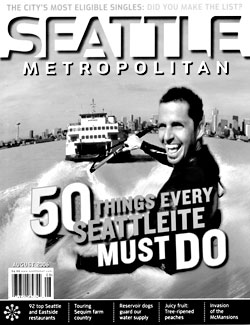City magazines have had a patchy history in Seattle. The gold standard was the original incarnation of Seattle magazine, which was published by KING-TV and the Bullitt family from the mid-1960s to the early ’70s. It exposed corruption and featured gays and Black Panthers on its covers; and its alums include Seattle Weekly founder David Brewster and author Tom Robbins. It folded because its provocative editorial content was ahead of the merchants and advertisers in this city, and its closure sent the message that Seattle was too small and provincial to support a true city magazine in the style of New York, Boston, Chicago, or Philadelphia.
In the mid-1980s, two new magazines, Pacific Northwest and Washington, duked it out for readership. PNW was a bit like Texas Monthly edited by environmentalists; whereas Washington (where I worked) was essentially a combination of Smithsonian and Arizona Highways. Both pursued city dwellers, but with expanded appeal designed to capture sophisticated readers from the entire Northwest. They competed intensely and were editorially ambitious: Both were nominated for National Magazine Awards early on. But in the end, neither model proved sustainable—in part because they tried to cover too much ground. Advertisers wondered why they were paying for readers in the Palouse or Portland when their desired targets lived in Seattle.
Fast-forward to the current imbroglio: Seattle has been revived, but in a more formulaic manner. And newcomer Seattle Metropolitan, its masthead stocked with Weekly vets, is a spin-off of a successful sister publication in Portland. They are locked in a classic magazine war, one aspect of which is that they seem—at least on the surface—more like one another than not (see “Glossy Gladiators,” Nov. 30, 2005). The current formula requires lots of reader service stories and nuggets aimed at high-end, high- rise Seattle. Every cover features a number—”50 Things Every Seattleite Must Do” or “155 Best Shops”— the kind of approach advocated by newsstand consultants who insist that numbers on the cover move copies, as do endless guides to doctors, dentists, and real estate.
But both publications offer some substance between stories about Seattle’s most eligible singles and the search for the city’s best chocolate chips. In the August issue of Seattle Metropolitan, Brad Warren delivers a solid story, “Reservoir Dog,” about how Seattle’s water supply is being impacted by global warming and how the engineers are working hard to slake the city’s thirst. Water stories are tough to make interesting, but Warren does a good job of explaining how this crucial resource is being managed by farsighted engineers. The most startling fact is that the Puget Sound region is warming at twice the global rate.
Likewise, August’s Seattle has an important story by Joe Follansbee, “The Disappearing Middle Class,” which looks at how Seattle is becoming a city of haves and have-nots. Follansbee backs his claim with census tract analysis that shows the income gap in the city widening dramatically (they crunched the numbers with the help of students from UW’s geography department). Seattle was once one of the most egalitarian cities in America; it now resembles a demonstration project for class stratification. Follansbee quotes UW professor Richard Morrill as saying that we’re not to blame: “There is nothing Seattle or Washington could have done to alter the outcomes from overwhelming global or national forces.” Yet the story provides a counterweight in the person of the Rev. Samuel McKinney, himself a recent refugee from Central District gentrification, who says: “Anything that’s wrong, we don’t have to accept.”
One of the problems with slick city mags is that substance is often subsumed by the graphics. At the old Washington magazine, we ran some terrific stories by The New York Times‘ Tim Egan, Ivan Doig, David Guterson, and others—but all people talked about was how great our photography was. The packaging also loses readers who might be interested in stories with some meat, yet are turned off by the superficial, rah-rah cover themes month after month.
Part of what moves these magazines off the rack is lifestyle stuff and a sense of luxury. But the fact that there are actually some stories in them worth reading seems to be their dirty little secret.







